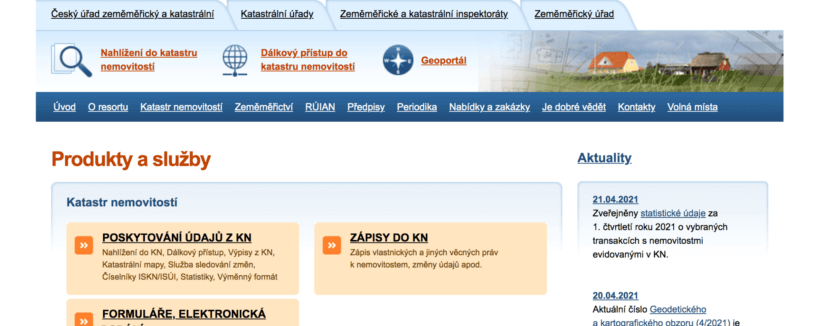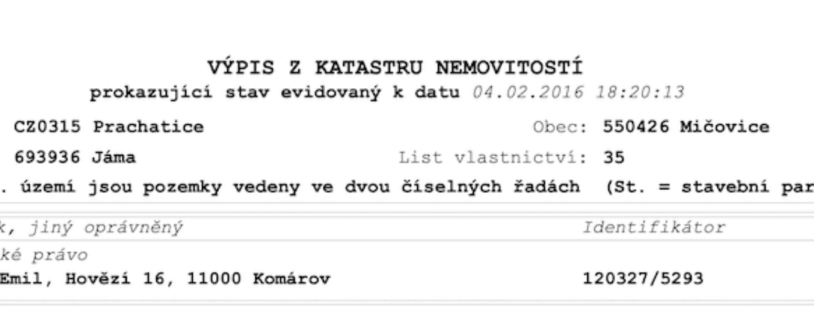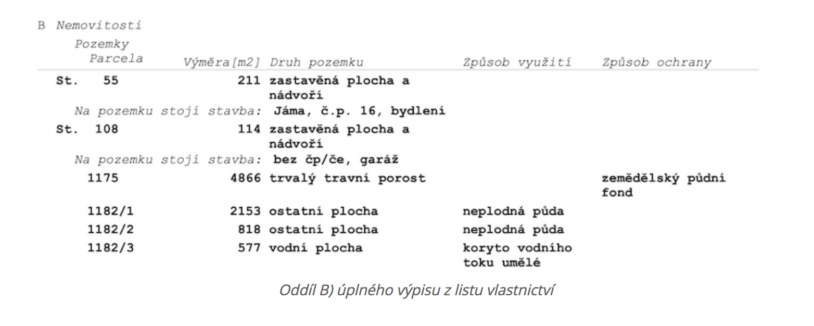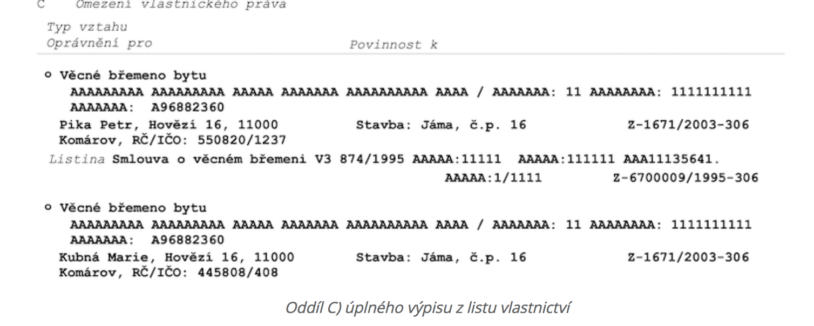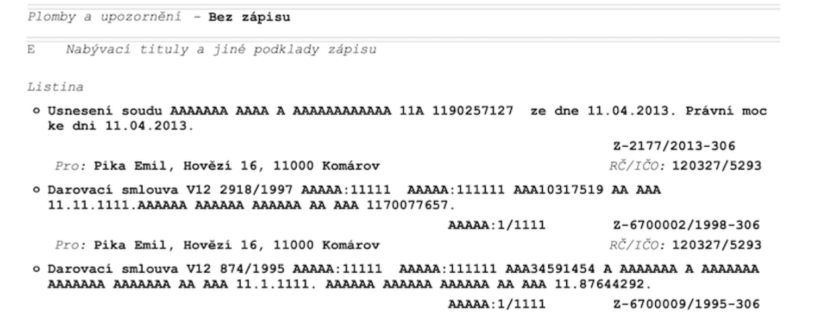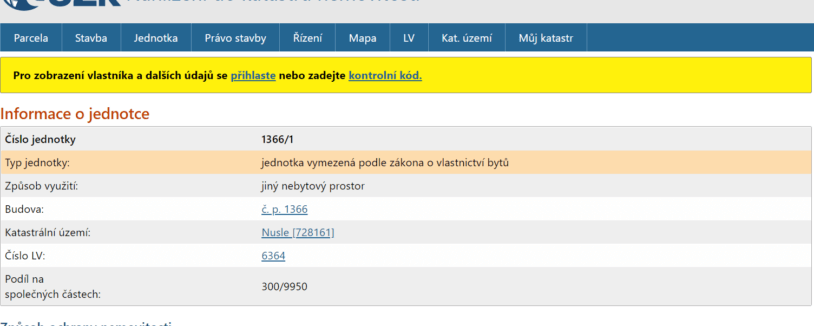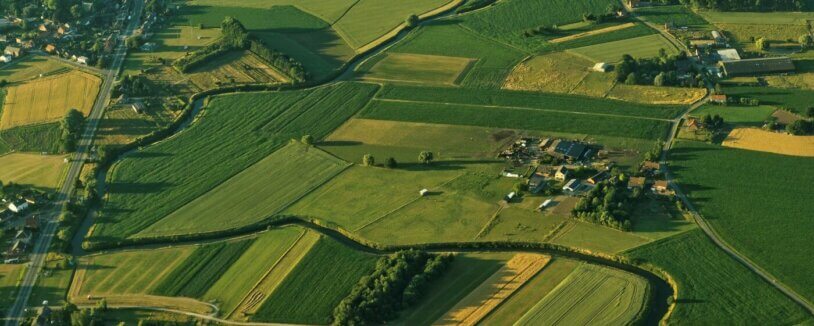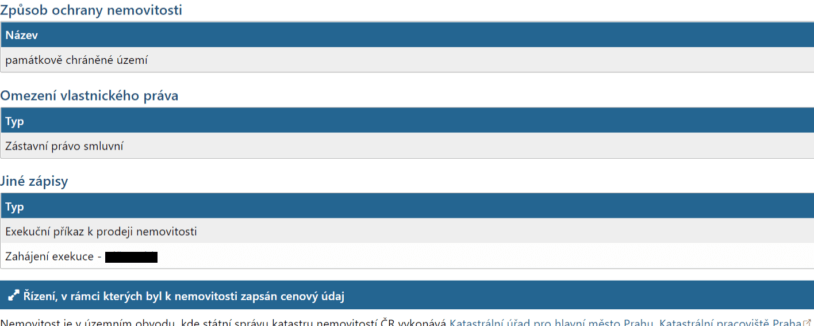What is the Land Registry?
This question is answered by the cadastral law and we will come out of it. The cadastre of immovable property is a public list that contains a set of data on immovable property as defined by the Cadastral Act, including its inventory, description, geometric and positional determination and registration of rights to it. It serves, among other things, for the protection of rights, for the purposes of taxes, fees and other monetary payments, for the protection of the environment, mineral wealth and conservation, for the development of the territory, for the valuation of real estate and for scientific, economic and statistical purposes.
This data is most often used for the protection of property rights, property valuation, environmental protection, but equally for tax and fee purposes. People most often search the real estate register for extracts, but thanks to the archives they can also consult other documents related to real estate. In the land registry you can also find:
- acquisition titles – inheritance, purchase or donation contracts,
- geometrical plans,
- mortgage contracts,
- building permits, land registry documents, property deeds, land registry documents, land registry documents, land registry documents, land registry documents, property deeds,
- declarations of owners,
- documents relating to easements
- and, of course, cadastral maps.
The Land Registry is indispensable for anyone wishing to examine land or property, and consulting the Land Registry will allow you to find out key information about the ownership and restrictions of the property.
Owners and other entitled persons are obliged to notify the Land Registry of changes to the information relating to their property within 30 days of the change, to mark the boundaries of the land permanently when requested to do so, and to fill in missing information or correct errors in documents submitted for registration. If they fail to mark the boundaries, the authority may mark them at their expense.
An available solicitor advises, “Remember that the Land Registry records land in the form of plots, buildings with a description or registration number (if they are not part of the land or building right) and buildings without a number if they are the main building. However, not all properties are included. For example, if you need information on underground structures or buildings under construction, your search in the Land Registry will not be successful.”
The state administration of the cadastre in the Czech Republic is provided by cadastral offices, surveying and cadastral inspectorates and the Czech Surveying and Cadastral Office.
The modern cadastre of real estate is fully digital and allows convenient online viewing of the cadastre, which saves time and costs.
Tip for article
Tip: Are you in the process of selling or buying a property? Then you will find a sample property purchase agreement drafted by our team of attorneys useful.
Free online access to the cadastre: What can you find out for free?
It’s easy to access the Land Registry free of charge online, which we mentioned above, but of course the traditional way of visiting the relevant land registry office and finding the information in person still works. You can find a complete list of cadastral offices and cadastral departments on the website of the Czech Cadastral Office.
If you are missing basic information such as a parcel number or a description number, you can use the mapping tools to quickly consult the cadastre.
Input data that you cannot do without when searching the cadastre are:
- usually the cadastral area or the name of the municipality,
- the descriptive number or the parcel number of the land,
- or the registration number of the proceedings.
However, it often happens that this information is unknown to you. In such situations it is possible to use the map on the website of the Czech Office of Surveying and Cadastre or a clearer map on ikatastr.cz.
Tip for article
Tip: Maps.cz also allows you to easily search for a plot. Just enter your desired location, right-click on it. One of the links that will pop up is the information about the parcel in the land register. There are also a number of other sites and applications for consulting the cadastre, such as ikatastr, which offers a more user-friendly environment than the classic cadastre of the Czech Land Register. It exists as a website and an application. An overview of cadastral offices is offered by ekatastr.cz. The Marushka application server is often used to publish and use GIS data in an online environment.
A completely different view of the real estate map is offered by the various price maps dealing with the actual selling (not advertised) prices of real estate. These are paid services that keep track of properties sold and extract information from completed sales recorded by cadastral offices. However, the level of each service can vary considerably.
A frequently asked question is whether it is possible to search the Land Registry by the name of the owner. This is not the case, but once you have found the land, you can find out the owner. While the online land registry preview is free, the full land registry extract is chargeable.
Are you solving a similar problem?
Proposal for entry into the Land Registry
Measure twice, cut once. That goes for official filings as well. Enrolment in the Land Registry is a formality, but a very important formality that is not to be underestimated. Do you need to register an easement in the Land Registry? Or a lien so you don’t lose the money you borrowed?
I want to help
- When you order, you know what you will get and how much it will cost.
- We handle everything online or in person at one of our 6 offices.
- We handle 8 out of 10 requests within 2 working days.
- We have specialists for every field of law.
How to search the Land Registry?
On the website of the Czech Land Registry you can find a shortened version of the title deed, which you can consult for free, and the full extract, which is charged at CZK 50 per page.
Let’s break down what you can find in the full title deed. In the introductory part you will find out the basic details of the property. The most important information is the cadastral area and the number of the title deed. In section A) you will then find information about the ownership of the property, the name, address and birth number of the owner of the property, or the amount of the co-ownership share if the property has more than one owner, or the fact that the property is jointly owned.
When reading the extract from the Land Registry, focus your attention on section B, which contains specific data about the property = parcel number, building number, unit number including area, type of land and type of use.
Undoubtedly the most important part for checking the extract from the Land Registry is Section C, where restrictions on the ownership right, which often affect the price of the property, are entered. The most frequently recorded restrictions are:
- Easements relating to the property.
- Encumbrances – usually a bank lien if the property was financed through a mortgage loan, but can also be a foreclosure lien if the property owner has a debt to a third party.
- Other rights or arrangements having the effect of rights in rem, such as pre-emption rights, prohibition of alienation or encumbrance or reservation of the right of repurchase.
The real estate registration continues with section D, where so-called other entries, such as notes or seals, are listed (pointing out that the cadastral office is conducting registration proceedings that have not yet been completed – ownership may soon change or a lien may be added, etc.).
The last section E then shows the title to the property, i.e. how the property was acquired. This section lists the contracts under which the owners registered on the title deed acquired the property. These may be contracts of sale, contracts of gift, decisions on inheritance, decisions of the courts, orders of acquiescence in the case of auctions, etc.
A free inspection of the Land Registry will provide you with basic information, while paid extracts from the Land Registry include detailed information about the owners and restrictions of the property.
What you can find out from consulting the Land Registry
A look at the Land Registry will reveal, for example, restrictions on ownership, such as easements or liens, which can affect the price of the property. When looking at the land register, it is usually based on knowledge of the property (house, land or housing unit). For example, when searching for a housing unit, you first enter the name of the municipality and its district, and then you need to know the descriptive number and the number of the housing unit itself. If you would like to search by, for example, the name or birth number of a person, then you will not succeed.
The most important information that can be obtained from consulting the Land Registry is the information about the owner of the property itself, i.e. name, surname and permanent residence, then the specification of the property, parcel number, descriptive number or unit number and their area.
This way you will know whether you are actually buying the property from the rightful owner. Another important piece of information is the restrictions of ownership that apply to the property. Examples of such restrictions are easements or liens that restrict the sale or purchase of the property.
Thanks to the relatively new intermediate step of searching the Land Registry, you first get only general information about the property, without the owner. You can therefore find out, for example, the purpose of use, the share in the common parts and the methods of protection for a residential unit.
The property owner himself can be reached in the next step. You either need to have an account for remote access to the land registry, or you just need to enter the code from the picture (CAPTCHA). You then get to the last and most important detail, the name of the owner.
Tip for article
Tip: Looking into the cadastre via the internet is fast and free, you only need to know the location of the land.
It is a very good idea to preview the Land Registry every time you are going to buy a property. It is an essential step that you should not skip. You can learn a lot from the Land Registry, but not everything. That’s why we’ve also given you some other tips to look out for.
Are you solving a similar problem?
Proposal for entry into the Land Registry
Measure twice, cut once. That goes for official filings as well. Enrolment in the Land Registry is a formality, but a very important formality that is not to be underestimated. Do you need to register an easement in the Land Registry? Or a lien so you don’t lose the money you borrowed?
I want to help
- When you order, you know what you will get and how much it will cost.
- We handle everything online or in person at one of our 6 offices.
- We handle 8 out of 10 requests within 2 working days.
- We have specialists for every field of law.
Tip for article
Our other articles will advise you:
What you won’t find out when looking at the Land Registry
However, there is information that you will not find out from consulting the Land Register. This may be, for example, that one of the owners has had the right to dispose of the property withdrawn. To verify this, we suggest that you request a document from the Land Registry proving the owner’s title of acquisition, i.e. the purchase or donation contract under which he acquired the property in question. From these documents it is possible to find out whether, for example, the owner’s power of disposition is limited (e.g. by a court decision or by contract).
Similarly, it is not possible to ascertain from the extract from the title deed whether, when selling a share in the property, the owner of the share is obliged to offer a pre-emption right to the other co-owners, when this information is based directly on the law.
Tip for article
Tip: If you enter the name of a municipality in the search on Mapy.cz, the entire cadastral territory of the municipality will be displayed.
Another problematic fact may be a case where the property being sold is registered in the Land Registry in the name of only one of the spouses, although the spouses do not have a reduced community of property and the property was acquired during the marriage and thus belongs to their community of property. In such a case, the other spouse, who is not registered as the owner in the land register but is in fact the owner, must expressly agree to the sale. The bank will always be required to agree to the sale if you finance the purchase of the property with a mortgage loan.
What about foreclosure proceedings?
The Land Registry extract will also not reveal pending or threatened foreclosure proceedings that are ready to be filed with the bailiff and may appear on the title deed before you acquire title to the property. Unfortunately, you will only find this out by asking the owner, who is obliged to disclose any legal defects of which he or she is already aware, including the aforementioned executions not yet listed in the land register. The initiated execution proceedings are entered in the cadastre, but the entry is made only after the delivery of the execution order. In the meantime, the owner may transfer the property – it is therefore advisable to request confirmation directly from the owner.”
Looking at the Land Registry online is a useful tool that allows you to quickly inspect a property from the comfort of your own home.
It is a very good idea to preview the Land Registry every time you are going to buy a property. It is an essential step that you should not skip. The Land Registry will provide you with a lot of key information, but certainly not all of it. That’s why we’ve also given you some other tips to look out for.
Summary
The Land Registry is a public list that contains key information about properties – for example, who owns them, what rights and restrictions are attached to them, or where they are located. Users can consult it online free of charge and find out, for example, whether a property is encumbered by a mortgage, easement or undergoing a change of ownership. Extracts from the cadastre can be obtained for a fee and it is advisable to request related documents, such as the title of acquisition, for thorough verification. However, the cadastre does not show everything – some legal facts (e.g. unrecorded executions or disputes) may not be recorded there.
Frequently Asked Questions
What is the Land Registry and what is it used for?
The real estate cadastre is a public register that records data about real estate – its description, location and mainly rights to it, such as ownership or easements. It serves for protection of rights, valuation, taxes and other legal and economic purposes.
How can I search for information in the Land Registry?
The easiest way is to use the online portal of the Czech Tax Office or applications such as ikatastr.cz. To find it, you need to know the cadastral area and the parcel number, the description number or the registration number of the proceedings. Searching by owner name is not possible.
What can I find out from consulting the cadastre and what not?
From the cadastre you can find out the owner, legal restrictions (easements, liens) and technical data about the property. However, you will not be able to find out about unrecorded foreclosures, legal pre-emption rights of co-owners or restrictions on the disposal of the property unless they are recorded directly in the title deed.
Is consulting the Land Registry free of charge?
Yes, basic online viewing is free, but the complete extract from the Land Registry is charged at CZK 50 per page. The extract contains more detailed information, including details of owners and restrictions.
How do I find out about any foreclosures or disputes on the property?
This information is not always up-to-date in the cadastre. You can only find out about unregistered foreclosure proceedings directly from the property owner, who is obliged to disclose this information. Registered foreclosures will only be entered into the Land Registry after the foreclosure order has been served.

